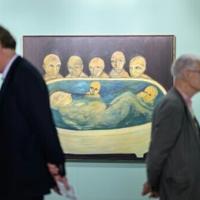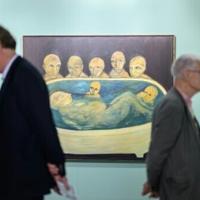Art Market
Annabel Keenan
May 29, 2025 5:37PM
Whether you buy art for your home or admire it in galleries and museums, establishing your taste is a personal journey. Some enthusiasts may be inspired by an artwork’s meaning or the artist’s story, embracing a message that resonates with them or perhaps challenges their own viewpoints. Others might be guided by factors like aesthetics and an artist’s market to help shape their preferences. And for some, the process is purely intuitive.
With countless commercial galleries, museums, and nonprofits worldwide, as well as informative publications and increasingly accessible platforms like social media, there are ample venues to view and engage with art. Here are five tips from leading art collectors on how to cultivate your taste as an art lover.
1. See as much art as possible
One of the surest ways to establish your artistic interests is to “look at as much art as you can,” said Gilbert Mathews, CEO and founder of Lucifer Lighting, the San Antonio–based high-end lighting company often used by museums and galleries. “Go to museum exhibitions and to galleries. Read auction catalogues and art magazines. See an exhibition even if it is not a period you would ever own. You will learn to appreciate quality, and your eye will become attuned to what great art is. Then in time, you will find something that you love.”
Over several decades, Gilbert has built a vast collection with his wife, Suzanne, who used to own an art gallery. “Kikuo Saito, Emilio Sanchez, Francisco Toledo, and James Brooks are some of the artists who Suzanne worked with and formed our early collection,” said Gilbert. “But we are very eclectic in our collecting and buy what we love.” The couple’s most recent purchase is a vibrant painting by the Texan artist Jammie Holmes.
Jammie Holmes, installation at Lucifer Lighting NYC flagship showroom, in collaboration with Marianne Boesky Gallery. Photo by Garrett Carroll. Courtesy of Lucifer Lighting.
Advertisement
In addition to museums and galleries, Michi Jigarjian, CEO and founder of the New York-based art and culture consultancy Work of Art Holdings, suggested adding nonprofits and small artist-run spaces to your list of places to visit. “Take note of what lingers, what makes you pause,” she said. “And don’t be afraid to live with a work in your mind before you live with it on your wall.” Jigarjian is also the managing partner and chief social impact officer of 7G Group and The Rockaway Hotel + Spa, which has a rotating art collection.
Beyond the local art scene, traveling to institutions in other areas of the world is another great way to cultivate a broader taste. “I travel a lot with my partner, Sean, and when we travel, we always go to museums and galleries to see art exhibitions,” said Patrick Sun, founder and executive director of the Hong Kong–based Sunpride Foundation. “I remember thinking, ‘The mountains and lakes will always be the same, but contemporary art exhibitions are constantly changing.’”
And if you can’t travel, browse art online. Platforms like Artsy are a great way to learn more about an artist’s practice, see some of their artwork, and potentially even buy a piece. Many artists post their work on social media, and galleries often share images of exhibitions on their websites.
2. Listen to your gut
Installation view of The Rockaway Hotel Lobby. Photo by Kyle Knodell. Courtesy of The Rockaway Hotel + Spa.
As you engage with art, learning what you like or don’t like can be a visceral experience. “I buy art with my body as much as my eyes,” said Shaokao Cheng, co-founder of luxury design company 18th Street Design Collective. “I sit with the piece, sometimes in silence, and pay attention to how it settles in me—my chest, my throat, my stomach. That physical response tells me more than any trend or appraisal ever could.”
The first artwork Cheng owned is a pencil sketch of a palm tree given to him by his friend, artist Enoc Perez. As he grew his personal collection, Cheng developed his taste intuitively, approaching art not for its monetary value or potential financial gain, but rather how it makes him feel.
Like Cheng, Jigarjian also takes an intuitive approach to engaging with art. “When I first began collecting art, I wasn’t thinking of ‘taste’ in the traditional sense. My entry point was intimacy— how a work made me feel, what it asked of me, and what conversations it opened up,” she said.
As Jigarjian’s collecting evolved, so did her criteria on what to buy. “Today, I make decisions about acquisitions with the same sensitivity but with greater intentionality,” she said. “I think about legacy, about dialogue across time and disciplines. I ask: What does this work contribute to the larger cultural conversation? Is this an artist I want my daughter to learn from one day? I’m drawn to artists who are rigorous, who engage with the community, and who move the needle.”
Above all, there has to be a personal connection, she added: “There’s an intuitive aspect that I trust implicitly—some works simply stay with you.”
3. Get to know artists
Portrait of Patrick Sun. Courtesy of Patrick Sun.
Portrait of Elizabeth Kingdon and Michael Rowe. Courtesy of Elizabeth Kingdon and Michael Rowe.
Artists are the lifeblood of the art world. Getting to know them and their stories can expand your experience as a collector and enthusiast. “The relationship I have with an artist enriches that experience, making the work feel not just seen, but understood,” Cheng said. “When I come across a piece that resonates with me, I often reach out directly to the artist to build a personal connection and learn more about their practice.”
Likewise, for Sun, whose collection is focused on LGBTQ+ artists and allies, the person behind the artwork is crucial. Over the last several years, Sunpride Foundation has partnered with museums in Asia to organize exhibitions with LGBTQ+ artists. “Collecting art for me has nothing to do with investment or decoration,” he said. “My collection is built entirely for the exhibitions we co-organised with public art institutions. When I need to decide what to collect, firstly, I think about how the work would fit into our LGBTQ-themed large-scale museum exhibitions; and secondly, I discuss with my team.”
Collectors Elizabeth Kingdon and Michael Rowe approach their engagement with art in a similar artist-centric way, focusing primarily on Indigenous Australian art. The couple cultivated their taste by researching artists and their communities. “We learned very quickly that if we were to expand our knowledge, we needed to travel to art communities (many very isolated), and so with our trusty camper trailer and Land Rover we covered thousands of kilometres across Australia,” said Kingdon. “We also volunteered twice at Balgo on the Tanami Road (a nine-hour drive from the nearest town), one of the oldest art centers in Australia. This was an amazing experience.”
4. Don’t be afraid to ask for ask for advice
The art world is a social space where art buyers and lovers can meet artists, dealers, and other enthusiasts to share tips and discuss their interests. This community can be a great resource to hone one’s eye. “At first, I bought what my friends who owned galleries suggested, but over a year or two, I started becoming friends with artists, with arts administrators, people who ran amazing nonprofits and artist residencies who weren’t solely focused on the market,” said Abby Pucker, a Chicago-based collector. “They understood how this sector worked and helped me understand the difference between seeing art as an investment and seeing art as a way into a world of experiences, adventures, stories, and relationships that I hold dear and will for the rest of my life.”
In addition to collecting art, Pucker is the founder of EarlyWork, a membership-based community of young collectors and creatives based in Chicago that embraces this social side of the art world. At EarlyWork, this can involve studio visits, dinners at local galleries, and previews of art fairs. Many museums have similar initiatives that the public can pay to join, like the Victoria & Albert’s Young Patrons’ Circle and the Museum of Modern Art’s Young Patrons Council. These and similar museum groups can come with perks like exclusive parties and programming, as well as visits to artist studios and private collections.
Art enthusiasts can also take advantage of the many free social activities in the art world, including gallery openings and public programming at museums and nonprofits, like the Brooklyn Museum’s First Saturdays, a free party with music, dancing, films, and creative events that takes place most months.
To develop taste, Pucker suggested to “treat it like a part-time job or at least a hobby that you really care about,” she said, adding that social media can be helpful as “an initial point of contact,” but it is worth going to events such as the opening of a show, a performance, or an exhibition walkthrough.
5. Study the art market, but not too closely
Even if you are not buying or enjoying art for its monetary value, researching the art market and broader trends in collecting can help get a sense of what genres and disciplines are popular. An artist’s market is essentially the publicly available information on what their work sells for and how this might have changed over time. While many transactions occur behind closed doors, art publications and market platforms like Artsy can be useful to learn about the market and individual artists’ prices. These resources might also list sales reports from art fairs and auctions, which can shed light on what art is currently popular. Artsy also publishes reports on art collecting, such as the recent Art Market Trends 2025.
Visiting auction houses to preview sales or watch them take place live is also a great way to get a sense of pricing, as this information is more readily available in these settings than in somewhere like a commercial gallery. Watching the sale of the Colin and Elizabeth Laverty Collection of Australian Indigenous art at the auction house Deutscher & Hackett first sparked Kingdon and Rowe’s interest in collecting a decade ago. “We were mesmerised,” said Kingdon. “The auction flew, and the prices were amazing and out of reach to us novices. However, determined not to leave empty-handed handed we luckily purchased a beautiful ‘Yawk Yawk’ piece by Owen Yalandja.”
Although useful when considering purchases and understanding the financial values of artworks, the market shouldn’t serve as the sole guide when deciding what pieces to engage with. “Market factors serve more as a data point than the main deciding factor as to whether I buy a work or not,” said Pucker. “The first and really only criterion that matters to me is whether I connect with the work or the story of the artist.”
This article is part of Artsy’s Collecting 101 hub, which features resources on everything you need to know about buying art. Explore more of Collecting 101.
Annabel Keenan
This post was originally published on this site be sure to check out more of their content



